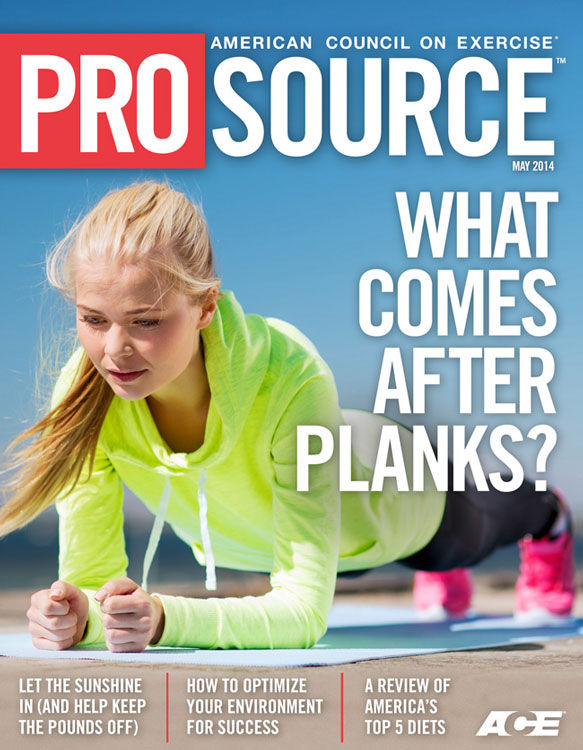
It is sometimes said that life is a series of choices. And individuals who are trying to lose weight or increase their level of physical activity often find themselves struggling to consistently make the right decisions. Many people erroneously blame a lack of willpower for their so-called failures, without realizing that willpower is a biological function and a mind-body response to the specific situation in which they find themselves. In fact, it might be more accurate to describe life as a series of minor struggles pitted against a person’s good intentions, a finite supply of willpower, and the innumerable outside forces that work to manipulate the decision-making process.
A review of the literature on self-control and decision-making abilities has shown that willpower is inherently limited (Baumeister, 2003), which is part of the reason why most people are more likely to complete an early morning workout than one that takes place in the evening—their willpower is simply too weak after a full day of trying to eat well and make other healthy choices to make one last commitment. Using willpower involves using one’s rational side to dictate what the emotional side wants—and it is not really a fair fight, as emotions are a far more powerful driver of decision-making than reason.

To make matters worse, billions of dollars are spent each year to manipulate our environments to drive us to make less healthy choices. Everything from the locations of fast food restaurants to the organizational system used at grocery stores is researched and optimized to get consumers to purchase what those companies want us to purchase, not what we know is best for us. There is also a form of emotional manipulation going at the same time, as people are encouraged to “treat” themselves to indulge because they “deserve” it. Companies take advantage of this powerful emotional pull to overpower customers’ intentions to make the more rational, healthier choice.
As a fitness professional, you’ve likely studied the many tools that can be used to help your clients overcome these outside forces, from operant conditioning and SMART goals to self-efficacy and social support. But what is sometimes overlooked is the fact that clients can alter their own environments to reduce the burden placed on their willpower—in effect, reducing the need to make decisions by manipulating the environment to make the choices for them.
Choice Architecture
Researchers conducting a study at Massachusetts General Hospital altered the way foods and beverages were displayed in the hospital cafeteria to examine how it would affect visitors’ purchasing patterns (Thorndike et al., 2012). Phase 1 of the study involved color-coding all products to alert customers to the healthfulness of what they were about to buy (green = healthy, yellow = less healthy, and red = unhealthy). This had a fairly dramatic impact on what people bought, suggesting that simply segregating food into similar categories in the refrigerator or pantry might help someone make better choices while preserving their willpower.
“The best way to strengthen willpower is to not rely on it so much,” explains Natalie Digate Muth, M.D., M.P.H., R.D., ACE’s Healthcare Solutions Director. For example, she suggests making eating healthy easier by purchasing healthy foods and making them highly visible in the kitchen. “Put out a fruit bowl,” suggests Dr. Muth. “Keep veggies and fruits cleaned and cut in clear containers front and center in the fridge rather than buried in a drawer.”
Simple Tips to Share with Clients
- Always have a bottle or glass of water on your desk at work.
- Prepare a healthy lunch and snacks at home before going to the office, and then only eat what you bring with you from home. Few things can trigger dietary anxiety more than a coworker asking, “Where do you want to go for lunch?” Having your lunch prepared ahead of time eliminates the need to make a choice.
- Keep your gym clothes in the car so you don’t have to stop at home before taking a separate trip to the gym. Nothing derails the intention to work out like a quick stop at home to change into gym clothes, as there are just too many potential distractions and stumbling blocks involved.
- Keep a pair of running shoes at work so you can take a quick walk during your lunch break. Simply seeing the shoes under your desk will help you make the choice to get up and move.
- At home, keep the television closed up behind cabinet doors, which will help reduce the impulse to sit down to watch TV every evening.
- Keep running shoes by the front door or sitting on the treadmill at home to make it easier to squeeze a quick walk into your day.
- Keep a yoga mat laid out on the floor to remind yourself to do your daily push-ups, stretching protocol or yoga session.
Consider this scenario: An obese client who often falls into the common trap of eating unhealthy snacks while watching television in the evenings decides to create an “unhealthy food drawer” in her kitchen, where she keeps potato chips, cookies and other favorites. Instead of simply grabbing a cookie from a package sitting on the counter on her way through the kitchen, she has to make a more conscious decision to eat poorly, thereby reducing the chances she will do so. In addition, she will no longer be prompted in the wrong direction by her environment. The second stage of this type of intervention might involve not purchasing those foods in the first place, but that can be an overwhelming first step for any new client. Dr. Muth suggests telling clients that, “If it’s too hard right now to completely remove the unhealthy stuff, at least decrease the amount and store it in hard-to-reach, hardly visible places.”
Phase 2 of the Mass General study involved utilizing what lead researcher Dr. Anne N. Thorndike and her colleagues call “choice architecture.” They simply changed the way foods and beverages were displayed in the cafeteria without telling the customers. For example, more water was added to the vending machines and baskets of water bottles were placed throughout the room. By simply manipulating the environment, the researchers saw a 25.8 percent increase in water sales above the already elevated levels reached after Phase 1 of the study.
What this type of research shows is that, in many ways, people’s choices can be made for them without them even knowing it. This can be a powerful tool for parents, for example, who are trying to help a child lose weight or simply eat more healthfully. By modifying the environment, limiting the number of options and making those options healthier, parents can simplify the decision-making process for their kids. This technique can, of course, also be used by clients trying to help themselves make better choices more consistently.
Removing the Obstacles to Exercise
“When it comes to exercise, if you’re using willpower, then you’re doing it wrong,” explains Jonathan Ross, author of Abs Revealed and an ACE spokesperson. “Be kind to yourself when seeking to adopt exercise behavior patterns by removing barriers to doing so. Doing the work of exercise can be challenging enough, so it’s best not to add challenge on the front end in the decision-making process.”
Ross suggests having clients pretend they have nothing on their schedules other than exercise. Ask them, “What time of day would you work out?” then see if you can help them make that happen. “Too often we force ourselves to exercise first thing in the morning because we think we ‘should,’” says Ross. Instead, clients should figure out what works for them and then organize their schedules around that time as much as possible.
“Make the block of time for exercise small enough that it is impossible not to do it,” says Ross. “On days where you are especially time-crunched, this makes the commitment small enough to not be overwhelming and helps you look for reasons why you can still do it rather than mull over reasons why you can’t.”
First Body, Then Mind
We’ve all been there. You’re sitting on the couch thinking, “I need to go hop on the treadmill.” But your mind deliberates, rationalizes, procrastinates and otherwise sabotages your intentions until you’ve decided that it’s not a big deal if you skip your workout that day. The mind took the lead and let you down.
Instead, just stand up and let the body take over before the mind derails your efforts. Once it gets going, the body tends to stay on task and get things done. The mind might object at first, but the resistance to making the effort will subside pretty quickly.
Clients can take advantage of this phenomenon by setting up cues to move and then acting on those cues without giving them a moment’s thought. For example, consider a client who works from home and has the ability—but not yet the desire—to get up and move throughout his day. He can set an alarm on his computer or phone that goes off every two hours, which is his prompt to either go for a 10-minute walk around the neighborhood or get on the exercise bike and ride for 10 minutes. There should be no deliberation. The alarm sounds, and the body just starts moving.
Finally, Ross also suggests that clients set “rules” to limit themselves to playing a new favorite track, artist or album only when working out. Want to listen to your favorite tunes? Then you have to do it while exercising. Another great option is to have clients pick a new TV show to binge watch, but only allow themselves to watch episodes while on the treadmill or exercise bike. Twelve hours behind on “House of Cards”? That’s 12 hours of treadmill time they’ve just committed to!
In a larger sense, some clients may have the ability to make changes in their lives that facilitate incorporating physical activity into their day without it seeming like an addition burden. Few things can wear down a new client’s morale like spending the day thinking, “I’m so tired, and I still have to work out.” Finding ways to move that are a normal part of the day can make a big difference. For example, consider a client with young children who is able to walk her kids to school each morning, thereby adding a few miles of walking into the day without otherwise changing her daily routine.
In addition, choosing a gym that you pass on your drive between work or school and home is essential. If that’s not possible, clients should consider altering their driving routes so that they always pass the gym on their way home, as driving an additional distance to reach the gym is just another obstacle the client has to overcome. Seeing the gym during every commute, even on days they don’t intend to go to the gym, will serve as a daily reminder of their commitment to a healthy lifestyle.
By optimizing their immediate environment, clients can set themselves up for long-term success, no matter what their goals. The hardest part for most newcomers to exercise is making the commitment and establishing a routine. Choice architecture and other tools can be used to simplify that process and minimize the reliance on a fickle and limited resource like willpower.
References
Baumeister, R.F. (2003). Ego depletion and self-regulation failure: A resource model of self-control. Alcoholism: Clinical and Experimental Research, 27, 281–284.
Thorndike, A. et al. (2012). A 2-phase labeling and choice architecture intervention to improve healthy food and beverage choices. American Journal of Public Health, 102, 527–533.

 by
by 



